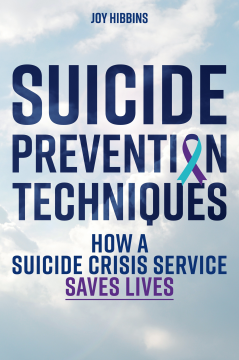
Additional Information
Book Details
Abstract
An unprecedented insight into the approach used by the innovative Suicide Crisis charity, a crisis centre that has so far achieved a zero suicide rate amongst their clients. This book explains their ethos, how they work and the ways in which their services operate.
The idea for the service grew out of the author's own lived experience of suicidal crisis, and her inability to find the right kind of help. This experience provides an understanding and awareness of what suicidal clients go through and the kind of help they require, and the success rate of the charity proves that the techniques used are effective. Covering relationship-building, providing intensive support, achieving a balance between protecting clients and giving them control, engaging high-risk men least likely to seek help, assessing risk accurately and more, this groundbreaking approach provides what is needed to save lives of people in suicidal crisis.
The author's royalties for this book are being donated to the charity Suicide Crisis.
Table of Contents
| Section Title | Page | Action | Price |
|---|---|---|---|
| SUICIDE PREVENTION TECHNIQUES | 5 | ||
| Contents | 7 | ||
| Introduction to the Author | 10 | ||
| Chapter 1 - Lived Experience: How it Impacts on our Services | 11 | ||
| Chapter 2 - The Relationship with Clients | 15 | ||
| Building a strong connection with clients | 15 | ||
| Creating an enduring connection | 21 | ||
| Recognising the experience of the individual | 26 | ||
| Providing individualised care | 27 | ||
| Celebrating unique individuals | 32 | ||
| Communicating care non-verbally | 35 | ||
| Connecting with the families of people at risk | 36 | ||
| Chapter 3 - The Safety Net | 41 | ||
| Chapter 4 - How to Balance Protecting Clients with Giving them Control | 53 | ||
| ‘It’s your decision’ | 53 | ||
| Being in control | 59 | ||
| Chapter 5 - Responding Effectively to Clients in Severe Distress | 67 | ||
| Post-traumatic responses, distress and fear: supporting clients effectively | 67 | ||
| Responding to clients expressing intense anger | 74 | ||
| Chapter 6 - Assessing Risk Accurately | 79 | ||
| Formal training in assessing risk | 79 | ||
| Knowledge of the client | 82 | ||
| Chapter 7 - Men and Suicide | 93 | ||
| Chapter 8 - The Team | 105 | ||
| Team members: personal qualities, skills and training | 105 | ||
| Support staff and their vital role in helping to save lives | 110 | ||
| Changing the power balance between clinician and service user | 111 | ||
| Chapter 9 - Working with other Services | 117 | ||
| The barriers | 117 | ||
| Working in partnership | 123 | ||
| Chapter 10 - The Future | 131 | ||
| Zero suicide: a helpful term or a hindrance? | 131 | ||
| New crisis services | 136 | ||
| References | 143 | ||
| Blank Page |
